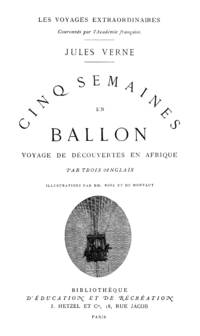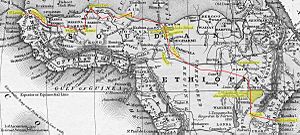Five Weeks in a Balloon facts for kids

Title page of a Hetzel edition
|
|
| Author | Jules Verne |
|---|---|
| Original title | Cinq semaines en ballon |
| Translator | Various |
| Illustrator | Édouard Riou and Henri de Montaut |
| Country | France |
| Language | French |
| Series | The Extraordinary Voyages #1 |
| Genre | Adventure novel |
| Publisher | Pierre-Jules Hetzel |
|
Publication date
|
1863 |
|
Published in English
|
1869 |
| Media type | Print (Hardback) |
| Followed by | The Adventures of Captain Hatteras |
| Text | Five Weeks in a Balloon at Wikisource |
Five Weeks in a Balloon (French: Cinq semaines en ballon) is an exciting adventure novel written by Jules Verne. It was first published in 1863. This book was special because it was the first time Verne perfectly blended thrilling adventures with interesting facts. He mixed a gripping story with details about science, geography, and history.
The novel gives readers a peek into the exploration of Africa. At that time, much of Africa was still a mystery to Europeans. Explorers were traveling all over the continent, trying to uncover its secrets. People were very interested in these kinds of adventurous stories about Africa. Because of this, the book became an instant success. It helped Jules Verne become financially secure. It also led to a long partnership with his publisher, Pierre-Jules Hetzel. Together, they published over sixty more books in the next forty years.
Contents
The Story of Five Weeks in a Balloon
An Amazing Journey Across Africa
The main character is Dr. Samuel Fergusson, a smart scholar and explorer. He decides to travel across the entire African continent. Africa was still largely unexplored back then. Dr. Fergusson plans to do this amazing journey in a special balloon. This balloon is filled with hydrogen gas.
He invented a clever device for his balloon. This device helps him control the balloon's height without losing gas or dropping heavy ballast. This means the balloon can stay in the air for a very long time. His goal is to connect the routes of other famous explorers. These include Sir Richard Burton and John Hanning Speke in East Africa. He also wants to link up with Heinrich Barth's travels in the Sahara and Chad regions.
The Route and Challenges
The journey begins in Zanzibar, which is on Africa's east coast. From there, they fly over many famous places. These include Lake Victoria and Lake Chad. They also pass over cities like Agadez, Timbuktu, Djenné, and Ségou. The trip ends in St Louis, located in modern-day Senegal on the west coast. The book describes some parts of central Africa as a desert. However, this area is actually a savanna, which is a grassland with scattered trees.
A big part of their early exploration focuses on finding the source of the Nile River. They achieve this goal in chapter 18 of the book. The second part of their trip is to connect with the routes of other explorers. Along the way, they face many exciting adventures. These challenges come from conflicts with local tribes or from the harsh environment itself.
Exciting Adventures and Escapes
Here are some of the thrilling moments they experience:
- They rescue a missionary who is about to be sacrificed by a tribe.
- They run out of water while stuck over the Sahara Desert with no wind.
- Giant bearded vultures attack their balloon. This leads to a dramatic moment when Joe, Dr. Fergusson's servant, bravely leaps out of the balloon.
- Later, they must take daring actions to rescue Joe.
- They narrowly escape a group of soldiers. This happens as their balloon slowly loses hydrogen and starts to fall.
- They hunt a bluebuck, a type of antelope. However, this animal was already extinct at the time the story takes place.
In all these adventures, the characters overcome their difficulties. They succeed mostly through their amazing determination and never giving up. The novel is full of lucky coincidences. For example, wind often picks up at just the right moment to save them. Or the characters look in the right direction at the perfect time. The story often suggests that a higher power is watching over them.
In the end, the balloon finally gives out. But it carries them far enough to reach friendly lands. From there, the protagonists eventually make it back to England. This means their incredible expedition is a success. The story ends quite suddenly after their African journey, with only a short summary of what happens next.
Film Versions
Several movies have been made based on Jules Verne's exciting novel:
- 1961 - Flight of the Lost Balloon was made in the United States. It was directed by Nathan Juran and starred Marshall Thompson.
- 1962 - Five Weeks in a Balloon was also made in the US. Irwin Allen directed it. The cast included Red Buttons, Fabian, Barbara Eden, Sir Cedric Hardwicke, Peter Lorre, Richard Haydn, and Barbara Luna.
- 1975 - Viaje Fantástico en Globo was a Mexican film. It was directed by René Cardona Jr. and starred Hugo Stiglitz.
- 1977 - Five Weeks In A Balloon was an animated film by Hanna-Barbera. Chris Cuddington directed this version.


